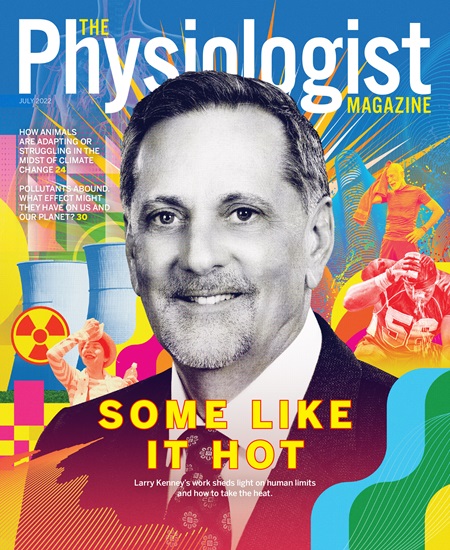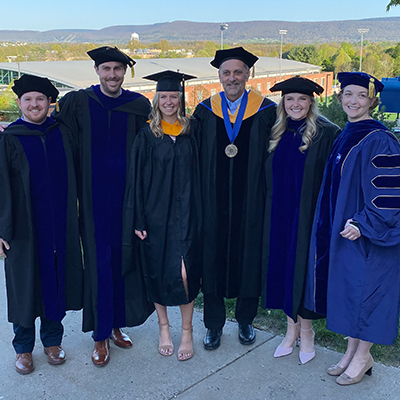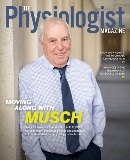Some like it Hot
From nuclear power plants to football fields to the changing planet, Larry Kenney’s work on thermoregulation sheds light on human limits and how to take the heat.
By Meredith Sell

When Larry Kenney, PhD, FAPS, arrived at Penn State in 1980, he didn’t know what his career would be. A PhD student in physiology, he thought maybe someday he’d teach at the college level and coach. Sports and the human body—those were his interests as a first-generation college graduate coming from the tiny coal mining town of Brenizer, Pennsylvania. But an event from a year earlier about 100 miles southeast of Penn State completely changed his career trajectory.
On March 28, 1979, in the early hours of the morning, a pressure valve in a nuclear reactor at Three Mile Island failed to close. Over the next 16 hours, the plant on a sandbar in the Susquehanna River came within an hour of total meltdown. The worst nuclear energy disaster in U.S. history led to the shutdown of the plant and kicked off a 12-year process of cleanup. That’s where Penn State researchers, including Kenney—who’s now a professor of physiology and kinesiology at the university—came in.
“When I got to Penn State, my adviser, Eliezer Kamon, had a contract to look at heat-stress issues related to workers who were going in and cleaning up the damaged reactor building,” Kenney says. “These guys were putting on three sets of plastic clothing, two or three pairs of gloves, respirators, masks, taping everything shut and then going into areas that were up to 165 degrees Fahrenheit. It took them a couple hours to get dressed, and they could only work in there for 20 minutes or so because they couldn’t evaporate any sweat.”
Kenney jumped into the research right away, collecting data from Three Mile Island as well as other nuclear power plants across the country. He also participated in lab-based projects at Penn State’s Noll Laboratory, the first freestanding building in the country dedicated to studying exercise and environmental physiology. Those projects included examining the different physiological responses of men and women to heat stress and the effects of different types of clothing on people working in the heat.
Kenney was hooked. Not only did human thermoregulation offer countless angles to explore, but the research findings were directly applicable to people’s lives. Things like hypertension, cardiovascular fitness, obesity and age all came into play.
As Kenney neared the end of his PhD program in 1982, Kamon had a medical emergency that prevented his return to the lab. Elsworth Buskirk, PhD, the founding director of the Noll Lab, asked Kenney to stick around as a postdoc and manage Kamon’s grants and research projects. Kenney agreed and soon found himself leading a research team of graduate students several years older than he was. “I was just one of the team,” he says. “I just happened to be the one who had to write grants and reports, be in charge of projects and do teaching on the side.”
Along the way, he started writing his own grant proposals, honing in on questions regarding the ability of older adults to tolerate high heat and humidity. He noted that when heat waves struck around the world, the vast majority of people who died or ended up in emergency rooms with heat-related illness were over the age of 65. He began wondering: “What physiologically changes with aging that causes us to be less heat-tolerant, and what can we do to improve those responses?”
Starting in 1986, his work on heat stress and the elderly was funded by the National Institutes of Health (NIH) for 29 years straight. With the help of graduate students and postdoctoral fellows, Kenney conducted dozens of cross-sectional studies, comparing college-age students to older adults. He looked at sweating rates, how many sweat glands in the skin individuals activated, how the cardiovascular system responded and how much blood the heart pumped to the skin in certain conditions. The insights gained were helpful—and not just for the elderly.
OVERHEATED FOCUS
At the turn of the 21st century, heatstroke was known, but it wasn’t well understood and addressed in arenas such as pro sports. In 2001, the death of Korey Stringer began to change that. A 27-year-old offensive lineman for the Minnesota Vikings, Stringer died August 1 that year after the second day of summer training. The cause: multiple organ failure due to exertional heatstroke.
At the time, NFL teams started summer training wearing full gear, all the pads and layers you’d see at the Super Bowl. Stringer, who was known to be a “prolific sweater,” according to ESPN, vomited three times on the unusually hot first day of training and left early on a cart to cool down. The second day, July 31, was even hotter, nearly 90 degrees. Stringer threw up once but otherwise pushed through practice until he fell over during a block bag drill and was again transported to air conditioning. When he was finally brought to the hospital after becoming unresponsive, his internal core temperature was 108.8 degrees.
Attorneys representing Stringer’s widow and young son enlisted Kenney to create an expert report on how much heat the athlete gained and why the treatment he received was suboptimal. Boxes of paper reports, autopsies and interviews arrived at Kenney’s office. The more he read, the more tragic the whole incident became.
“When there’s a sudden heat challenge, like the first day of football camp … the body hasn’t geared up yet to respond to the heat stress,” Kenney says. “It takes usually between nine and 14 days to fully acclimate to exercise in a hot environment.”
Stringer’s life could have been saved by timely and appropriate heatstroke treatments. His death led to seismic change in the NFL. For Kenney, it further confirmed the value of understanding heat stress.
HEAT WAVES BECOME NORMAL
What was a disproportionately hot summer day in 2001 may now be normal. Thanks to the advancement of global climate change, extreme heat events are becoming more frequent and severe—and an aging baby boomer population means the number of at-risk elderly is growing as well. What environments are too hot (and humid) for humans to handle? That’s the question Kenney’s current NIH-funded research aims to answer, with a particular focus on the upper limits of body temperature regulation for the elderly.
 In March 2020, as COVID-19 swept the globe, the new project kicked off. In the first two years, due to pandemic limitations, data collection focused on younger subjects. Now, Kenney’s team is recruiting subjects ages 65 to 85 so they can compare
heat tolerances to the younger subjects. Collaborators at Vrije Universiteit Amsterdam in the Netherlands and University of Sydney in Australia are collecting the same data to see if the findings ring true in different climates.
In March 2020, as COVID-19 swept the globe, the new project kicked off. In the first two years, due to pandemic limitations, data collection focused on younger subjects. Now, Kenney’s team is recruiting subjects ages 65 to 85 so they can compare
heat tolerances to the younger subjects. Collaborators at Vrije Universiteit Amsterdam in the Netherlands and University of Sydney in Australia are collecting the same data to see if the findings ring true in different climates.
“The Three Mile Island situation … was an immediate impending disaster,” Kenney says. “Global warming and climate change is a more slowly developing, but equally impending, disaster unless we do something about it.”
In determining upper limits of temperature regulation for elderly versus young adults, Kenney’s current research aims to provide practical information that can be used to support human health and safety when extreme heat events happen. That could look like community alerts and warning systems, as well as guidance for emergency rooms and retirement homes to triage the most vulnerable elderly before, and when, heat hits.
Really, that’s been Kenney’s research goal all along: to make discoveries that can ultimately help people.
“While our lab sometimes focuses on cellular and molecular mechanisms, we never lose sight of the big picture: how we can impact community health, athlete and worker safety, and public policy by knowing more about the physiology and biophysics of human temperature regulation.”
This article was originally published in the July 2022 issue of The Physiologist Magazine.
At the turn of the 21st century, heatstroke was known, but it wasn’t well understood and addressed in arenas such as pro sports. In 2001, the death of NFL lineman Korey Stringer began to change that.
“The Three Mile Island situation … was an immediate impending disaster. Global warming and climate change is a more slowly developing, but equally impending, disaster unless we do something about it.”
The Physiologist Magazine
Read the Latest Issue
Don’t miss out on the latest topics in science and research.
View the Issue Archive
Catch up on all the issues of The Physiologist Magazine.
Contact Us
For questions, comments or to share your story ideas, email us or call 301.634.7314.


